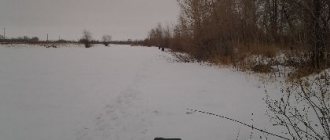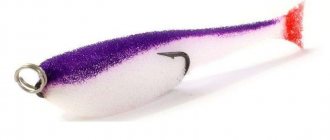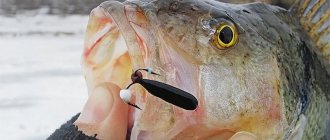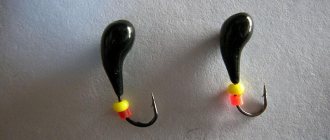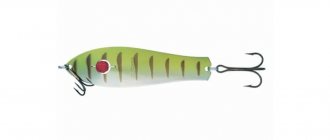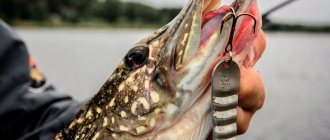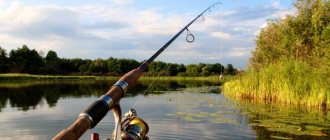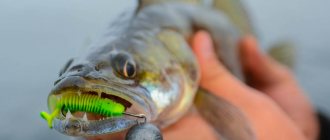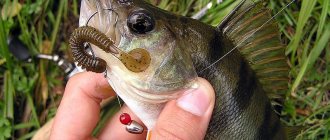Bersha winter mooring sites
This fish always gathers in schools, which helps when searching for its habitat and winter stopover. When winter comes and ice forms on the reservoir, the predator remains active. It can be found in shallow water or in areas where it was present in the fall.
In the middle of winter, the fish goes to depths, where they spend most of their time. It rises from the pits only to feed. At the end of winter, the pre-spawning feast begins, so the predator moves behind schools of small fish to places where streams and meltwater flow into the reservoir.
Advantages of winter fishing for bersh with sprat
Fishing for pike perch and bersh does not require special skills or large expenses. If you use sprat as bait, you can easily catch the predator using standing tackle. This bait is perfect for both passive and active fishing.
During what periods is the bite especially active?
Fishing begins at dawn. The activity of the predator reaches its limit at 7 o'clock in the morning. After this, the flocks begin to move around the pit. They are not easy to track. Before dusk, the bersh is active again, but with the onset of darkness the biting stops. In cloudy weather, fish bite all day long, but with a strong north wind there is no point in going fishing.
The nuances of fishing in different bodies of water
Fishing on different types of reservoirs has its differences. So, fishing on a pond or lake is different from fishing on a river. Features of winter fishing should be taken into account when selecting equipment, bait, etc.
On the lake
How to find a suitable fishing spot on an unfamiliar lake depends on a number of factors:
- The fisherman must know the size and depth of the reservoir where the fish will be caught, and understand what kind of fish he expects to catch.
- He should acquire the necessary equipment for catching fish.
First, anomalies in the bottom topography are identified. This can be done by measuring the depth in the holes at a short distance from each other. Characteristic signs of such anomalies are cracks, holes and grass. When a place is found, you need to make sure that there are fish there. Algorithm of actions:
- A quick way is to go around the holes with search gear. Judging by the result, you can decide on the fishing method and select the necessary gear. The place where the fish bite more often needs to be fished. You can continue searching in other places if the fish are not biting in the place you find. It is recommended to use bait to get the best results.
- If there is enough time to search, then you should find suitable holes and feed them until the fish appear. This must be done only in those holes where the fish are already biting, otherwise you can use up all the bait and waste time without getting a bite. Thus, there is a possibility of finding and concentrating inactive or distant fish around this hole.
Walking fishing is a tactic in which the fisherman walks around all the holes with gear. At the same time, he fishes a large area of the reservoir without staying long on 1 hole. Time is spent drilling a hole and testing for catch.
The advantage of this method is that the angler has a high chance of finding active fish in the place where you least expect it. You can find places where fish feed in a small area.
The disadvantages of this method include the fact that if the fish do not gather in schools or are inactive, then the gear for searching and checking the hole will not force it to bite.
On the river
The chances of catching large fish (pike perch, bream, roach, silver bream) in the current are greater than in still water. There are no fish weighing less than 100 g in fast currents.
Fishing on the river has its own difficulties, which must be fully foreseen; the secrets of fishing with fast currents and great depths are as follows:
- The length of the fishing line should be much greater than the depth of the river.
- The line under the hole will not go straight, but will take an arched shape. The vibrations produced by the hand will not reach the bait, so you should not use fishing skills in still water.
Fish that feed need to be given the bait closely. She will bite the bait if you give the latter the necessary movements. For this purpose, it is necessary to evaluate the strength, speed and direction of the current in order to predict what movements the bait will make.
Under such conditions, it is difficult to give natural movements to the bait. To do this, you should know the features of the gear and have experience.
For bloodworms, maggots or larvae, the natural movement will be a smooth descent towards the bottom with a slight shift towards the current. To enhance the effect, you should take short pauses between movements of the bait.
What equipment to use
In winter, tackle for catching bersh must be durable. This fish has strong bites, so it can offer powerful resistance.
Fishing rods and lines
The main gear is a durable fishing rod with a large reel and a supply of fishing line. Some anglers don't use a reel. When moving from one hole to another, they wrap the fishing line around their arm through their elbow. But this is not the best way. In addition, it requires special skills. The fishing line clings to the ice, making it difficult to handle.
A metal nod is used together with the fishing rod. The bite of this predator is neat and leisurely, so the nod should be sensitive. You don’t need any special expensive gear to catch bersh in winter.
Leashes and hooks
A rig with a tee will allow you to get a good catch even with cautious bites. You can catch a predator using jigs with a hook. The shank of the hook must be long so that a whole fish can be hooked. For hunting bersh, ordinary spinners for vertical retrieve are also suitable. On them, sprat is used as additional bait.
Winter fishing for bersh with sprat
In winter, hunting for bersha requires patience and endurance. The main thing is the choice of bait: fishing with sprat gives a rich catch and a chance to catch a trophy specimen. This small fish will be a wonderful bait for catching predators. You can buy it in a store or catch it yourself. You can use both regular hooks and a variety of artificial baits.
Fishing tactics
Tactics are chosen depending on the equipment:
- if you want to catch a bersh in a fast current, then a passive method is suitable: you need to tie a sinker at the end of the main line so that it holds the tackle in the place you have chosen. Above, at a distance of at least 10-15 cm, the leash should be secured. All the main work will be done by streams of water;
- On rivers with weak currents, you can use an oscillating spoon. After moving, the bait floats with the current and slowly returns to its original depth. The oscillation range is 25−50 cm from the bottom surface;
- Fishing with artificial bait using sprat bait is done in the same way as with an empty hook. The rod is raised 30-40 cm and returned to its previous position. The bait sinks and glides smoothly through the water. When playing with bait, you need to keep the duration of pauses under control, because at this moment the predator attacks the bait. Sometimes the bersh is inactive and ignores the playing sprat, being tempted by the stationary bait.
For passive fishing, holes are drilled close together so that they fit on one small patch, for active fishing - every 6 m. In the first case, fishermen chase the predator throughout the water area and as a result get a large catch. In the second, fishing enthusiasts enjoy leisurely fishing and outdoor recreation.
Selecting a location
In winter, to catch bersh with sprat you need to choose the following places:
- areas without silt;
- holes filled with snags;
- edges where fish look for food;
- underwater rubble of stones.
Select several suitable areas and install gear on each of them. Working depth indicators on fishing rods should be different. The largest number of bites will show you the place where you can get a good catch.
How to plant sprat
Sprat is baited on tackle in different ways:
- when fishing with one hook, the sting is inserted into the mouth and out through the back;
- The best way to provoke a predator to bite is bait placed by the tail;
- a puncture under the fin on the back allows you to place the bait in the water in a natural position;
- if you use a tackle, it is more suitable to attach it in an arc to treble hooks in such a way that one puncture is near the head, and the second is on the back.
Tackle
3
For silicone baits
Vibrotails and twisters 5-7 centimeters long, preferably made of “edible” material, are used as silicone baits for catching bersh Most often, “boot” shaped jig heads are used, since when stationary on the bottom, the hook of such heads sticks up at an angle of 45 degrees, and a predator can attack the bait even when no animation occurs. Equipment for catching bersh with silicone consists of the following elements:
Fishing rod
Durable fishing rod with a reel 70-100 cm long with a glass or carbon fiber whip. The reel must be equipped with a ratchet or a button for releasing the line.
fishing line
To catch bersh, a monofilament line with a diameter of 0.2-0.3 mm is used.
Nod
When catching bersh, the nod is almost always used, since often weak bites of this predator can be noticed only by the nod. Metal nods are used: plate or spring. The end of the nod is often equipped with a bright ball.
Expert opinion
Knipovich Nikolai Mikhailovich
Zoologist, hydrobiologist. I am interested in fishing at a professional level.
Interesting! Some anglers use a drop-shot rig when fishing for bersh. This type of equipment includes a sinker and a piece of fishing line with a rigidly fixed hook onto which a silicone bait is attached.
On the jig
It is more often caught with a jig during the deep winter, when the activity of the bersh is low. Mormuscular tackle looks like this:
Fishing rod
The fishing rod must be powerful enough, equipped with a reel: built-in or attached with the option of a ratchet or line release.
fishing line
When fishing with a jig, use a fishing line with a diameter of 0.15-0.22 mm. The thinnest line is used when fishing with baitless jigs.
Lures
The large Uralka jigs have proven themselves to be the most effective. Bersh are also successfully caught using large “devils”.
Bait
To catch bersh with a jig, they use bloodworms, which are pre-tied into bundles, and brushes of worms. In addition, fry are used as bait.
For the spinner
Bersh are caught well with spinners and balancers. The tackle for trolling is the same as for fishing with silicone baits.
Lures
Spoons for catching bersh are narrow and small (5-7 cm) in size. The spoon should not go far away from the vertical axis, i.e. Such baits are of the “stud” . Depending on the food preferences of the bersh in a particular pond, spoons can be one-color or two-color with edges made of brass, copper or beryllium bronze. The spinners are equipped with a hanging tee with a bright drop or with a wobble made of red woolen thread.
Balancers for catching bersh are also small in size - 5-6 cm. Since fishing takes place at great depths, bright balancers that are visible from afar are usually used.
For fishing with sprat
Tulka is a small fish from the herring family that lives in the same reservoirs as bersh. Tulka leads a gregarious lifestyle. A distinctive property of sprat is its high fat content .
In winter they catch only with sprat, harvested in the fall. In the fall, it is caught by small fish and frozen in freezers. Before fishing, take out the required amount of sprat and store it in a warm pocket while fishing. It is recommended to place an unfrozen sprat on the hook - this way it stays on the hook better. The gear for catching sprat looks like this.
Fishing rod
A fishing rod for fishing with sprat can be intended for active play, and then it is called a “bale ,” or it can be a donka. In any case, the fishing rod must have sufficient power. A reel is required.
fishing line
When catching bersh with a “baler”, use a monofilament line with a diameter of 0.2-0.3 mm. One or two leashes no more than 20 cm long with hooks are tied to it at a short distance from the sinker.
Sinker and hooks
The sinker has the mass necessary for fishing in specific conditions. It is tied to the end of the fishing line. The hook can be single, but tees with a bright drop are used much more often. The sprat is placed behind the back.
Bottom tackle
Bottom tackle is also used for catching bersh with a sprat, but it is somewhat different from the “baler”. The fishing rod usually has legs to securely place the fishing rod on the ice. There is only one leash attached, and it is long, since the fish must play in the current.
Expert opinion
Knipovich Nikolai Mikhailovich
Zoologist, hydrobiologist. I am interested in fishing at a professional level.
Important! With any fishing method, sprat must be regularly replaced with fresh ones. The characteristic smell is quickly washed out by the current, and the fish loses its attractiveness to predators.
Additional items
When fishing with a spoon, pieces of the same sprat are often attached to the hooks . When trolling above a tricky lure, you can tie a hook onto which a piece of fish meat is also attached. When fishing with a jig head, a sprat is often used instead of a silicone bait. Although it does not hold well on the hook, it can bite much better.
Useful tips and tricks
- When fishing with sprat, you need to periodically change the bait; predators are attracted by the smell of fish, so they try to remove it from the hook. The effectiveness of the nozzle decreases after 30-60 minutes. When the fat is washed out, the sprat becomes less flavorful and the bait no longer attracts fish.
- Pay close attention to the nod. They bring a good catch and periodic control hooks.
- The sprat for bait must be fresh.
- A small bait, no more than 3-4 cm long, is attached to one hook.
- For hunting, you can use the same baits as for pike perch, but smaller in size.
- The predator is constantly on the move. It searches for food at great depths. For ice fishing for this predator, it is better to use a fishing rod with a large reel. The line will not get tangled in strong winds, and you will spend less time moving from hole to hole.
- This fish can remove the bait without touching the hook, and hooking too quickly will leave you without a catch.
Usually pike perch and bersh stay near the bottom, but sometimes predators rise higher. Bites often occur at a distance of 1.5 m from the bottom.
Spinning, fishing for pike perch and bersh
Pike-perch “delicacies” Photo by the author
Pike-perch and bersh have always been desirable prey for amateur fishermen and sportsmen. And not only as sport fishing trophies, but also from a gastronomic point of view. These fish are very tasty, especially when served cold, in aspic. They are included in the menu of the best restaurants.
For each season, fishing for pike perch and bersh has its own specific baits. First of all, the most common and popular now are jig baits. This is where most of the pike perch are caught. Then come foam rubber fish with a length of 5-8 cm, sometimes smaller ones are used, but in the fall for large pike perch they use baits longer than 8 cm. Foam rubber baits with doubles are preferable than with a single hook, as they detect fish better. The rigidity of the pike perch mouth has long been known, which sometimes requires more than one hook. Foam rubber baits with a tail look more similar in appearance to a live fish, while foam rubber baits without a tail play better.
Lures
Focusing on foam rubber fish, it must be said that it is better to place the bait weight not round, but slightly flattened on the sides, for example, a “lentil” weight. This improves the play of the bait, and when it falls to the bottom, such a weight sometimes first stands on its edge, and then falls on the ground. At the same time, the foam fish makes spinning movements that attract the predator. Therefore, with such a “foam rubber” equipment, there are many pike perch bites from the bottom. In general, foam fish under certain conditions are often more catchy than jigs and silicone baits. This is caused by the peculiar play of the “foam rubber”: the baits are located at the bottom almost vertically or at an angle to the surface of the ground.
Meanwhile, silicone baits have their advantages. They are varied in color, have an active game, where twisters can serve as an example, and when the bite is good, it is better to catch pike perch and bersh using silicone. Green twisters with sparkles are especially good. Pearlescent whites also performed well. These baits are quite large: if you unfold such a twister to its full length, it will be at least 12 cm. But even small pike perch and bershi grab these twisters quite willingly. And it has been noticed that pike perch is not afraid of large baits, despite its narrow throat.
Bersh baits are usually small. These can be twisters and vibrating tails with actively working tails. Moreover, it is better if the colors of the bait are contrasting, for example: a red back of a bait on a white body or a yellow-green body of a bait with a red tail. Among the series of similar silicone baits is a fish with a “pocket”. Usually the casting range with it is small due to air resistance, but nevertheless it is a catchable bait. It is better to have all of the above baits in two forms: with open tees and so-called “non-hooking”. The best option for such bait may be a weight with a suspended offset hook hidden in a twister.
Large vibrating tails also work well in catching pike perch and bersh, especially in the fall. At depth and at dusk, luminous vibrotails are irreplaceable. Continuing the topic of jig baits, we should probably dwell on spinnerbaits. Sometimes these baits become the most popular among predators. In addition, they are like two in one, that is, they have a petal and a weight with bait. Everything here is easy to replace: both the weight and the hook with a twister. To do this, simply unfasten the clasp and make a replacement. There is no need to place a large petal; No. 1 will do just fine. Apparently, thanks to the two active elements of the bait, pike perch can be just as active. Instead of a twister, a spinnerbait can also be equipped with a foam fish. This also diversifies the game of the bait. And during passive biting, such a replacement often arouses the interest of the predator.
Also, jig spinners are successfully used to catch pike perch. They fly far, pull the line well and provoke a large pike perch to bite. And, most likely, there will be fewer bites than with soft foam and silicone baits on a jig head, but the fish will be larger. Just like on spinnerbaits, a blade No. 1-2 will be enough. For catching bersh, smaller “pinwheels” are suitable: with a flat “lentil” weight, a “double zero” petal and a single hook pointing upward.
In snaggy areas, it is necessary to use jig spinners that are “non-snagging”. As one of the equipment options, you can install a foam rubber fish with an offset hook.
You can also add Long John and artificial worms to the list of pike perch baits made of silicone. The Long John bait is mounted on an offset hook and looks like a narrow fish, and among the baits it looks like a slug. The advantage is that if it is broken by the hook at the bait site, then the bait can simply be cut off and the remaining part placed on the offset hook. The predator will grab the bait even if only the tail remains. You can make a Long John from a regular vibrating tail. To do this, you just need to cut off its belly, leaving a narrow part for attaching to the hook.
Artificial worms are similar baits. Like Long John, they can be used in a non-snagging version. To do this, it is enough to place the bait like on an offset hook, recessing the hook tip into the body of the bait.
The color of the bait is important when fishing at shallow depths. But even at depth, baits that react to ultraviolet radiation work better. You can see them better. These are baits of bright lemon color, green with sparkles, pearly white and, oddly enough, carrot color. It is clear that in even deeper places, luminous decoys are clearly visible to fish.
Mouse-colored “foam rubber” also worked well, especially against the background of a light bottom. And despite the seemingly inconspicuous color, baits of this color can be called universal for any day and weather. In late autumn, polyurethane foam baits can come in handy. They are not distinguished by good play when retrieved, but at the bottom they behave like “foam rubber” - they stand vertically or at an angle to the bottom, making oscillatory movements. But the advantage of these baits is that they do not get wet. And the “foam rubber” can get wet and lose its qualities. But it is important that the double is closer to the tail of the polyurethane foam fish, since it stands vertically and the grip is often on the tail. And when fishing from the bottom, a pause is very important. The wiring should not be entirely stepped, but with a shortened step, so to speak. This is one revolution of the coil at a fast pace and a pause at the bottom for 3-4 seconds. And such fishing definitely requires a sensitive rod. This is the only way to accurately determine the bite.
| “Iron” for pike perch Photo by the author |
Wabiks made from goat hair also work well. The bait flies perfectly and retains air bubbles once in the water. Their main advantage is their long casting range; moreover, they fly less than all other baits and allow you to fish in great depths. For catching pike perch and bersh, step fishing is most often used, somewhat shortened: two turns of the reel, a pause. The time the bait falls when fishing for pike perch should be no more than 1-2 seconds. Pike perch does not like to take the bait higher than half a meter from the bottom. Therefore, both the pause and the “step” are shortened. But sometimes a pause is very important. You need to let the bait lie quietly on the bottom for about 4 seconds and only then start retrieving. Especially at the beginning of fishing. But in normal mode the bait remains on the bottom for about 2 seconds. The technique of dragging the blende along the bottom is also used, sometimes in combination with stepped wiring. This is reminiscent of a running donkey. Here are the main criteria for fishing when fishing for pike perch. The remaining subtleties can be learned through experience.
Places for catching pike perch are chosen where the bottom is hard, there are drops and edges from the shallows to the pit, whirlpools with reverse currents, and entrances and exits from the pits. It is not the pits themselves that should be fished, but their edges and slopes in depth.
On reservoirs among even depths, spits and shallows often become catchable places where they border on pits.
Periods of zander in pike perch
The first period of active pike perch biting begins in the spring, somewhere from mid-April to mid-May. In essence, this is a pre-spawning meal of pike perch, when the fish takes it greedily and confidently. At this time, pike perch gather in schools, compete for food, and the capture of the largest pike perch is possible precisely during this period. We can say that this period of a week or a little more is the best in pike perch fishing for the entire year. But in order to get on the move, you need to regularly be near the water and make control casts, since folk signs no longer work, and the weather often does not correspond to climatic standards. And the time of zander feeding is determined experimentally.
Usually after May 10 there is no good bite for pike perch. It has just spawned and is guarding the eggs. The only person who can get caught is a guard like this, who must, of course, be released. The pike perch, which has not spawned, takes the bait, but, of course, specimens up to half a kilo are caught.
From the beginning of June, pike perch begins to eat after spawning. There are already quite decent trophies here, but there are almost no schooling fish now. The pike perch has scattered throughout the entire reservoir, and after catching a large predator, you can hardly hope to catch the same one in this place. Towards the end of June, pike perch appears less and less often in fishermen's catches during the day. Only at early dawn and late evening are there good releases of large pike perch. And by mid-summer, in some places it switches mainly to night hunting. At this time, successful night fishing is possible on spits, rifts, and at the entrances and exits of pits. In the summer, the most popular baits are: spinners, spoons, wobblers. Pike perch is especially well caught using wobblers. Fishing is carried out at shallow depths, where the potential food of the predator is fattened - bleaks, verkhovkas and other small fish.
As autumn approaches, fishing for pike perch with jigs begins. In general, spring and autumn are periods of active jig fishing. In the summer, only light jig heads of about 6 g can bring success. In the fall, a heavy jig is used, which is used for fishing at fairly large depths. More often, successful fishing occurs in the predawn and evening twilight using luminous baits. And the period of autumn fishing for pike perch can be called the longest of the year. It sometimes takes until the end of November. October is recognized as the most successful month. Although during this period there is no zhora, as in the spring, but, knowing the habitat of the predator, you can successfully catch it all autumn with a heavy jig with various silicone baits, as well as heavy spoons. Fishing is done using stepwise wiring.
In November, pike perch are still fishing, and are more active during periods of warm weather. But with fewer bites, the largest trophies come across, like in the spring. And it was noticed that the largest pike perch are caught exactly a week before freeze-up. This period is considered the time for catching trophy fish. With the establishment of ice, spinning fishing becomes possible only on urban reservoirs and rivers, where the water temperature is always higher. The pike perch takes it, but, of course, for fishing with a spinning rod you need open water.
Always along with pike perch you also come across bersh. It is rarely hunted on purpose. But a big plus in catching it: it sometimes takes throughout the daylight hours, when pike perch bites are very rare. Therefore, you can catch pike perch at dawn and continue fishing for bersh. Although this fish is mostly small, bershis stay in schools, and fishing can be active and exciting.
Alexander Tokarev November 15, 2012 at 00:00
